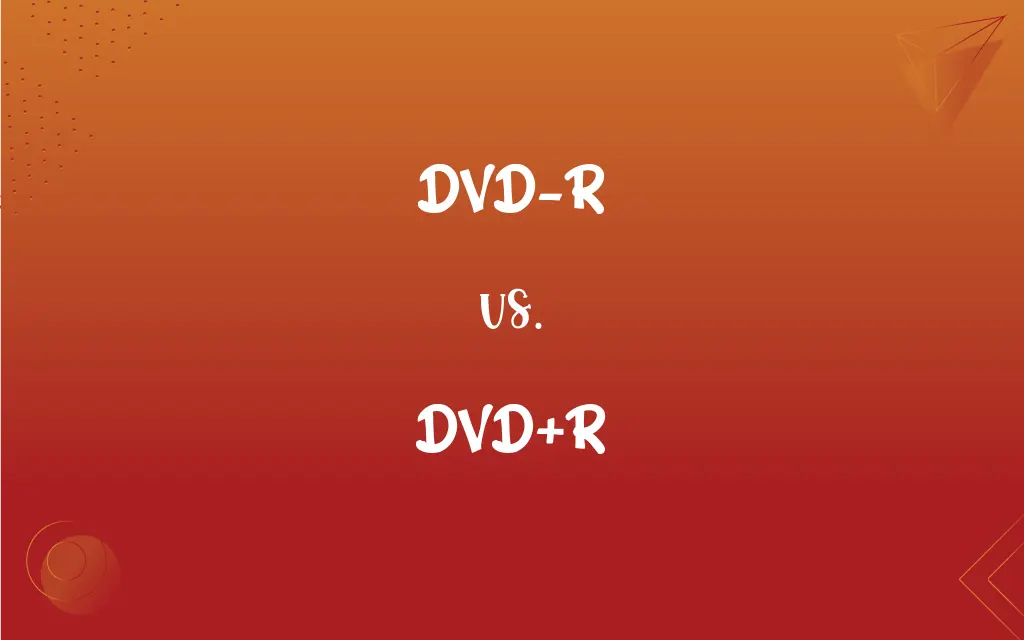DVD-R vs. DVD+R: What's the Difference?
Edited by Janet White || By Harlon Moss || Updated on October 17, 2023
DVD-R is a write-once format supported by the DVD Forum, while DVD+R is also a write-once format, but backed by the DVD+RW Alliance.

Key Differences
DVD-R and DVD+R are two different types of recordable DVD formats that, at a glance, appear very similar. DVD-R was the first write-once format that was developed and was formally approved by the DVD Forum, an international group of hardware and software companies. Conversely, DVD+R came about as a result of the DVD+RW Alliance, a group of corporations that believed they could improve upon the original DVD-R specifications.
While the main distinction between DVD-R and DVD+R initially arose from different supporting entities, there are technical differences as well. Specifically, the manner in which each format handles defect management and the way they format and rewrite data diverges. DVD+R, for instance, has more robust error management systems than DVD-R, which can be particularly useful when archiving or sharing data.
Compatibility used to be a primary concern for users choosing between DVD-R and DVD+R. Earlier, certain DVD players and drives could only read one of these formats. However, as technology evolved, many modern DVD players and computer drives became capable of playing both formats, diminishing the compatibility concern. Still, if someone has an older DVD player, it might be more compatible with DVD-R discs than with DVD+R discs.
A notable feature of DVD+R is the ability to add data in multiple sessions, even if the disc is not finalized. This means users can add data in separate instances until the disc is full. In contrast, with a DVD-R, the user often has to finalize the disc, which means no additional data can be added afterward. In the context of practical application, someone using a DVD+R for data storage might find this feature especially advantageous.
Comparison Chart
Backing Organization
DVD Forum
DVD+RW Alliance
ADVERTISEMENT
Defect Management
Less advanced
More advanced
Multiple Data Sessions
Often requires disc finalization
Allows multiple sessions without finalizing
Compatibility
Slightly better with older devices
Might require newer playback devices
Data Rewrite Method
Different method
Uses a unique lossless linking method
DVD-R and DVD+R Definitions
DVD-R
The first recordable DVD version supported by the DVD Forum.
For compatibility with older players, I always use DVD-R.
ADVERTISEMENT
DVD+R
A write-once DVD format supported by the DVD+RW Alliance.
I bought a spindle of DVD+R discs for my data backup.
DVD-R
An optical disc with a storage capacity of up to 4.7 GB.
I can fit my entire presentation on a single DVD-R.
DVD+R
A variant of DVD that uses lossless linking for data recording.
The lossless linking feature in DVD+R ensures a smooth video playback.
DVD-R
A digital storage medium that can't be recorded over once data is burned.
Once I finalize the DVD-R, I can't add more files to it.
DVD+R
A digital storage format known for its advanced defect management.
For crucial files, I prefer DVD+R because of its reliable error management.
DVD-R
A write-once optical disc storage format.
I saved our family videos on a DVD-R so they won't be accidentally overwritten.
DVD+R
A storage medium similar to DVD-R but with distinct technical specifications.
Though similar to DVD-R, my recorder specifically requires DVD+R discs.
DVD-R
A format widely accepted by standalone DVD players.
I chose DVD-R because I knew it would play on my grandparents' DVD player.
DVD+R
An optical disc that allows adding data in multiple sessions.
Using DVD+R, I added more photos to the disc over time without finalizing it.
FAQs
Can both DVD-R and DVD+R store video and data?
Yes, both formats can store video, data, and audio files.
What do DVD-R and DVD+R stand for?
DVD-R stands for "Digital Versatile Disc-Recordable," while DVD+R stands for "Digital Versatile Disc+Recordable."
Is there a difference in recording speed between DVD-R and DVD+R?
Both have similar speed grades, typically ranging from 1x to 16x, but the actual speed may depend on your recorder and media quality.
Are DVD-R and DVD+R universally compatible with all players?
DVD-R has slightly higher compatibility with older DVD players, but most current players support both formats.
Can recording be paused on DVD-R or DVD+R?
Yes, both support multi-session recording, but a new session may reduce the remaining available storage.
How durable are DVD-R and DVD+R discs?
Both are fairly durable but can be prone to scratches or damage from heat and sunlight, affecting performance and lifespan.
Are DVD-R and DVD+R rewritable?
No, both formats are write-once, meaning data cannot be overwritten once recorded. DVD-RW and DVD+RW are their rewritable counterparts.
Is the storage capacity affected by the format (video, data, etc.)?
No, the capacity remains the same, but the file size of your content determines how much fits on the disc.
Are DVD-R and DVD+R the same?
No, they are similar types of recordable DVD media but are developed by different consortia and have slight technical differences.
Can I determine if my player supports DVD-R or DVD+R?
Yes, check the player's manual or look for the logos on the device indicating supported formats.
Do DVD-R and DVD+R discs require finalizing?
Yes, both types of discs need to be finalized to play in standard DVD players.
How long can data stored on DVD-R and DVD+R last?
If properly cared for, they can last for decades. However, it's recommended to back up important data in multiple places.
Are DVD-R and DVD+R still relevant with the advent of streaming and cloud storage?
While their popularity has decreased due to streaming and cloud storage, they're still used for data archiving, video recording, and distribution.
What is the storage capacity of DVD-R and DVD+R?
Both typically hold 4.7 GB of data on standard single-layer discs, and about 8.5 GB on dual-layer discs.
Is there a noticeable price difference between DVD-R and DVD+R?
Prices are comparable, and any difference is often due to brand, quantity, or sales rather than the format itself.
Will future technologies render DVD-R and DVD+R obsolete?
Likely, as storage technologies continue to evolve, but they remain useful for specific purposes, especially where internet access is limited or non-existent.
Can I use DVD-R and DVD+R in computers?
Yes, if your computer's optical drive supports these formats.
Are there any specific uses where DVD-R is preferred over DVD+R or vice versa?
DVD-R is often preferred for DVD video authoring due to slightly higher compatibility, while DVD+R may offer some technical advantages like more robust error management.
Why were two different formats, DVD-R and DVD+R, created?
They were developed by different consortia (DVD Forum and DVD+RW Alliance) due to disagreements over recording standards.
How should I dispose of unwanted DVD-R and DVD+R discs?
They should be recycled properly as electronic waste, not thrown in regular trash. Many communities have e-waste recycling centers.
About Author
Written by
Harlon MossHarlon is a seasoned quality moderator and accomplished content writer for Difference Wiki. An alumnus of the prestigious University of California, he earned his degree in Computer Science. Leveraging his academic background, Harlon brings a meticulous and informed perspective to his work, ensuring content accuracy and excellence.
Edited by
Janet WhiteJanet White has been an esteemed writer and blogger for Difference Wiki. Holding a Master's degree in Science and Medical Journalism from the prestigious Boston University, she has consistently demonstrated her expertise and passion for her field. When she's not immersed in her work, Janet relishes her time exercising, delving into a good book, and cherishing moments with friends and family.































































